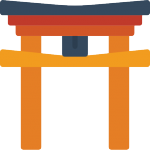PART A_1
Let’s introduce ourselves to each other.
自己紹介をしましょう。
PART A_2
My name is ________________. What is your name?
PART A_3
I am ________________. Nice to meet you.
PART A_4
Nice to meet you too, ________________. Let’s begin our lesson!
PART B_1
We’ll read aloud the words and expressions below. Please repeat after me.
I will check your pronunciation.
I will check your pronunciation.
単語、表現を音読します。講師に続いて読みましょう。講師は発音を確認します。
(Please send the mispronounced words and expressions to your student.)
PART B_2
 |
sightseeing spots
観光名所
|
 |
recommend
勧める
|
 |
shrine
神社
|
 |
popular
人気のある
|
 |
culture
文化
|
PART B_3
Now, let’s review some words from part B_2.
ではいくつかの単語を復習してみましょう。
(Please review the mispronounced words and expressions from part B_2.)
PART B_4
PART C_1
We’ll read aloud the sentences below. I will check your pronunciation and intonation.
文を読みます。講師が発音、イントネーションについて確認します。
(Please send the mispronounced words and expressions to your student.)
PART C_2
| 1. | Have you ever been to Japan? |
| 2. | Do you know any good sightseeing spots in Japan? |
| 3. | I recommend that you ~. |
| 4. | Do you know how to visit a Japanese shrine? |
| 5. | What is the capital of Japan? |
| 6. | First, ~. |
PART C_3
Now, let’s review some words and expressions from part C_2.
ではいくつかの単語、文章を復習してみましょう。
(Please review the mispronounced words and expressions from part C_2.)
PART C_4
PART D_1
We’ll read aloud the dialogue below. I will check your pronunciation and intonation.
会話文を読みましょう。講師が発音、イントネーションについて確認します。
(Please send the mispronounced words and expressions to your student.)
PART D_2
| Tutor: | What is the capital of Japan? |
| Student: | The capital of Japan is Tokyo. |
| Tutor: | I see. Have you ever been to Japan? Do you know any good sightseeing spots in Japan? |
| Student: | Yes, I recommend that you visit Japanese shrines and temples. They are very popular among many tourists. You will learn a lot about their culture. |
| Tutor: | Do you know how to visit a Japanese shrine? |
| Student: | First, you need to bow before entering the gates of the shrine. Make sure to walk on the side of the path when entering the shrine as the middle of the path is only for gods. |
PART D_3
Now, let’s review some words and expressions from part D_2.
ではいくつかの単語、文章を復習してみましょう。
(Please review the mispronounced words and expressions from part D_2.)
PART D_4
PART D_5
Please fill in the blanks and read aloud the dialogue. I will check your pronunciation and intonation.
空欄を埋めて、会話文を読みましょう。講師が発音、イントネーションについて確認します。
PART D_6
| Tutor: | What is the capital of Japan? |
| Student: | The __________ Japan is Tokyo. |
| Tutor: | I see. Have you ever been to Japan? Do you know any good sightseeing spots in Japan? |
| Student: | Yes, ____________ you visit Japanese shrines and temples. They are very popular among many tourists. You will learn a lot about their culture. |
| Tutor: | Do you know how to visit a Japanese shrine? |
| Student: | First, ______________ bow before entering the gates of the shrine. Make sure to walk on the side of the path when entering the shrine as the middle of the path is only for gods. |
PART D_7
Now, let’s review your answers.
では、あなたの答えを復習してみましょう。その後、修正したあなたの答えを読んでみましょう。
(Please review your student’s answers by sending the correct answers in complete sentences. After that, ask your student to read aloud his or her corrected answers.)
PART D_8
PART E_1
Now, please fill in the blanks to answer the following questions.
I will check if your sentences are complete and if the grammar is correct.
I will check if your sentences are complete and if the grammar is correct.
空欄を埋めて、質問に答えましょう。講師は文法と完全な文章であるかを確認します。
PART E_2
| 1. | Have you been to the USA? |
| Answer: | Yes, I _________ to the USA. |
| 2. | Do you know any good sightseeing spots in Japan? |
| Answer: | I _________ that you visit Mt. Fuji. |
PART E_3
Now, let’s review your answers.
では、あなたの答えを復習してみましょう。その後、修正したあなたの答えを読んでみましょう。
(Please review your student’s answers by sending the correct answers in complete sentences. After that, ask your student to read aloud his or her corrected answers.)
PART E_4
PART E_5
Now, please make complete sentences to answer the following questions.
I will check if your sentences are complete and if the grammar is correct.
I will check if your sentences are complete and if the grammar is correct.
次に、質問に答えるために完全な文を作ります。講師は文法と完全な文章であるかを確認します。
(Please send the sentences that need grammar corrections to your student.)
PART E_6
| 1. | Do you know how to visit a Japanese shrine? | |
| Answer: | . | |
| 2. | What is the capital of Japan? | |
| Answer: | . |
PART E_7
Now, let’s review your answers.
では、あなたの答えを復習してみましょう。その後、修正したあなたの答えを読んでみましょう。
(Please review your student’s answers by sending the correct answers in complete sentences. After that, ask your student to read aloud his or her corrected answers.)
PART E_8
PART F_1
Now, you will ask me the questions below. Fill in the blanks to complete the sentences. I will check if your sentences are complete and if the grammar is correct.
あなたが講師に質問します。完全な文章になるように空欄を埋めましょう。
講師は文法と完全な文章であるかを確認します。
講師は文法と完全な文章であるかを確認します。
(Please send the sentences that need grammar corrections to your student.)
PART F_2
| 1. | What is _________ of Taiwan? |
| Tutor: | The capital of Taiwan is Taipei. |
| 2. | Do you know any good ________ in the Philippines? |
| Tutor: | I recommend that you visit the Rizal Park. |
PART F_3
Now, let’s review your answers.
では、あなたの答えを復習してみましょう。その後、修正したあなたの答えを読んでみましょう。
(Please review your student’s answers by sending the correct answers in complete sentences. After that, ask your student to read aloud his or her corrected answers.)
PART F_4
PART F_5
Now, you will make questions.
I will check if your sentences are complete and if the grammar is correct.
I will check if your sentences are complete and if the grammar is correct.
次に講師に質問するために完全な文を作ります。講師は文法と完全な文章であるかを確認します。
(Please send the sentences that need grammar corrections to your student.)
PART F_6
| Student: | What | ? | |
| Tutor: | The capital of the Philippines is Manila. | ||
| Student: | Do | ? | |
| Tutor: | I recommend that you visit the Shibuya Crossing. |
PART F_7
Now, let’s review your answers.
では、あなたの答えを復習してみましょう。その後、修正したあなたの答えを読んでみましょう。
(Please review your student’s answers by sending the correct answers in complete sentences. After that, ask your student to read aloud his or her corrected answers.)
PART F_8
PART G_1
Let’s do a role play with the given situations.
以下の設定でロールプレイをしましょう。
PART G_2
| Situation 1: |
You are talking to your American friend. Please tell your friend something about Japan.
あなたはアメリカ人の友達と話しています。日本のことについて話してみましょう。
(Your tutor will pretend to be your American friend.)
|
| Items to mention: |
– famous sightseeing spots in Japan – the best time to go to Japan |
PART G_3
| Situation 2: |
Your British teacher wants you to tell the class what you know about Japan. Please tell everything you know.
イギリス人の先生が、あなたが日本について知っていることをクラスのみんなへ教えてほしいと言っています。あなたの知っていることを話しましょう。
(Your tutor will pretend to be your British teacher.)
|
| Items to mention: |
– climate of each area in Japan – seasonal events in Japan |
PART G_4
| Situation 3: |
You are at a restaurant. A foreigner is asking you about table manners in Japan. Please tell him/her about it.
あなたはレストランにいます。外国人客に日本のテーブルマナーについて尋ねられました。彼/彼女に日本のテーブルマナーについて教えましょう。
(Your tutor will pretend to be the foreigner.)
|
| Items to mention: |
– what Japanese people say before and after eating – the right way to hold chopsticks and how to use them |